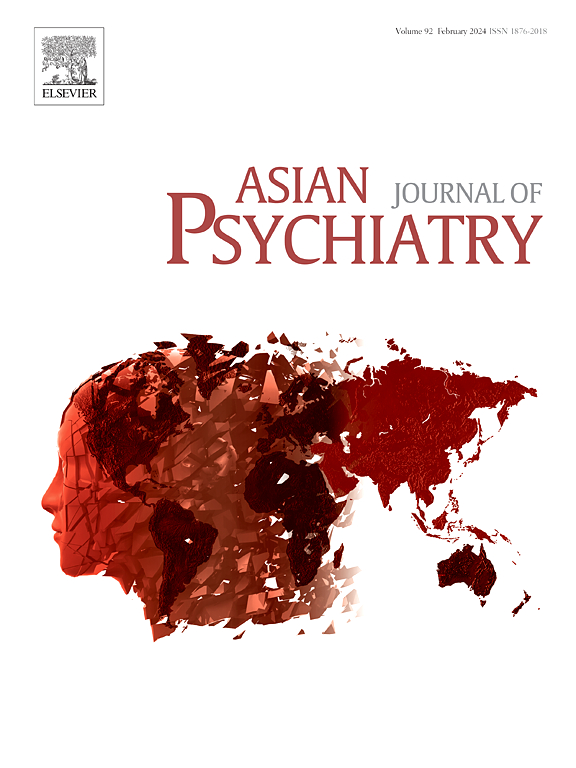What triggers suicidal ideation in daily life? A real-time study among young people with mood disorders at risk of suicide
IF 4.5
4区 医学
Q1 PSYCHIATRY
引用次数: 0
Abstract
Suicidal ideation (SI) is a dynamic phenomenon influenced by environmental, interpersonal, and emotional factors. However, its short-term predictors in daily life remain poorly understood. This study aimed to identify factors associated with SI in daily life among young people with mood disorders at risk of suicide, using ecological momentary assessment (EMA) to capture contextual data in real time. Over 14 days, 112 young people (75 % female, aged 12–24) who were diagnosed with mood disorders completed EMA surveys three times daily. Multilevel logistic regression models assessed concurrent, time-lagged, and adjusted associations between SI and environmental, interpersonal, and emotional factors. SI was most reported when participants were at home (61.0 %) or not alone (56.3 %). Key factors associated with increased SI risk included being with family (vs. alone) (OR = 1.54, 95 %CI: 1.01–2.34), experiencing family-related life events, such as conflicts (OR = 3.13, 95 %CI: 1.10–8.90). Other emotional factors linked to SI included perceived burdensomeness (OR = 1.37, 95 %CI: 1.14–1.64), thwarted belongingness (OR = 1.29, 95 %CI: 1.10–1.53), and sadness (OR = 1.93, 95 %CI: 1.56–2.40). In contrast, happiness was associated with a lower risk of SI (OR = 0.71, 95 %CI: 0.57–0.89). Sadness also predicted subsequent SI (OR = 1.54, 95 %CI: 1.26–1.90) and was a significant predictor of changes in SI, even after accounting for prior SI (OR = 1.32, 95 %CI: 1.06–1.65). These findings underscore the importance of real-time emotional and interpersonal contexts, particularly family conflict and negative affect, in the emergence and persistence of SI in daily life.
在日常生活中是什么引发了自杀的念头?一项针对有自杀风险的情绪障碍年轻人的实时研究。
自杀意念是一种受环境、人际和情绪因素影响的动态现象。然而,人们对日常生活中的短期预测仍然知之甚少。本研究旨在利用生态瞬间评估(EMA)实时获取情境数据,确定有自杀风险的情绪障碍年轻人日常生活中与自杀相关的因素。在14天的时间里,112名被诊断为情绪障碍的年轻人(75% 为女性,年龄在12-24岁)每天完成三次EMA调查。多水平逻辑回归模型评估了科学探究与环境、人际和情感因素之间的并发、时滞和调整关联。当参与者在家(61.0 %)或不单独(56.3% %)时,SI最多被报道。与SI风险增加相关的关键因素包括与家人在一起(与独自一人相比)(OR = 1.54, 95 %CI: 1.01-2.34),经历与家庭有关的生活事件,如冲突(OR = 3.13, 95 %CI: 1.10-8.90)。与SI相关的其他情绪因素包括感知负担(OR = 1.37, 95 %CI: 1.14-1.64)、受挫的归属感(OR = 1.29, 95 %CI: 1.10-1.53)和悲伤(OR = 1.93, 95 %CI: 1.56-2.40)。相反,快乐与较低的SI风险相关(OR = 0.71, 95 %CI: 0.57-0.89)。悲伤也能预测随后的SI (OR = 1.54, 95 %CI: 1.26-1.90),即使在考虑了先前的SI (OR = 1.32, 95 %CI: 1.06-1.65)之后,它也是SI变化的重要预测因子。这些发现强调了实时情绪和人际环境,特别是家庭冲突和负面影响在日常生活中SI的出现和持续中的重要性。
本文章由计算机程序翻译,如有差异,请以英文原文为准。
求助全文
约1分钟内获得全文
求助全文
来源期刊

Asian journal of psychiatry
Medicine-Psychiatry and Mental Health
CiteScore
12.70
自引率
5.30%
发文量
297
审稿时长
35 days
期刊介绍:
The Asian Journal of Psychiatry serves as a comprehensive resource for psychiatrists, mental health clinicians, neurologists, physicians, mental health students, and policymakers. Its goal is to facilitate the exchange of research findings and clinical practices between Asia and the global community. The journal focuses on psychiatric research relevant to Asia, covering preclinical, clinical, service system, and policy development topics. It also highlights the socio-cultural diversity of the region in relation to mental health.
 求助内容:
求助内容: 应助结果提醒方式:
应助结果提醒方式:


